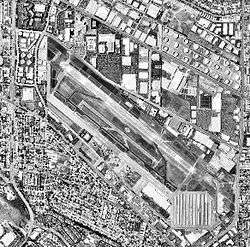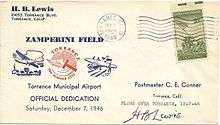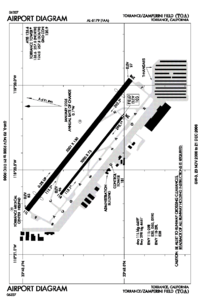Zamperini Field
Zamperini Field (IATA: TOA, ICAO: KTOA, FAA LID: TOA) is a public airport three miles (5 km) southwest of downtown Torrance, in Los Angeles County, California, United States.[1]
Zamperini Field Lomita Landing Strip | |||||||||||||||
|---|---|---|---|---|---|---|---|---|---|---|---|---|---|---|---|
 31 May 1994 USGS photo | |||||||||||||||
| Summary | |||||||||||||||
| Airport type | Public | ||||||||||||||
| Owner | City of Torrance | ||||||||||||||
| Location | Torrance, California | ||||||||||||||
| Elevation AMSL | 103 ft / 31 m | ||||||||||||||
| Coordinates | 33°48′12″N 118°20′23″W | ||||||||||||||
| Website | www.ci.torrance.ca.us/... | ||||||||||||||
| Map | |||||||||||||||
 KTOA | |||||||||||||||
| Runways | |||||||||||||||
| |||||||||||||||
| Helipads | |||||||||||||||
| |||||||||||||||
| Statistics (2005) | |||||||||||||||
| |||||||||||||||


The airport is classified by the FAA as a Regional Reliever[2] and was once known as Torrance Municipal Airport; it was renamed for local sports and war hero Louis Zamperini on December 7, 1946, the 5th anniversary of the Pearl Harbor attack.
History
The airport was completed by the United States Army Air Forces on March 31, 1943,[3] and was known as Lomita Flight Strip. It was an emergency landing field for military aircraft on training flights. It was closed after World War II and the War Assets Administration (WAA) turned it over to local government. Once turned over to the City of Torrance it was renamed Zamperini Field on December 7, 1946.
Facilities
Zamperini Field covers 506 acres (205 ha) and has two asphalt/concrete runways: 11L/29R, 5,000 x 150 ft (1,524 x 46 m) and 11R/29L, 3,000 x 75 ft (914 x 23 m). It has one asphalt helipad, 110 x 110 ft (34 x 34 m).[1]
In the year ending May 31, 2005 the airport had 173,027 aircraft operations, average 474 per day: 99% general aviation, 1% military and <1% air taxi. 499 aircraft are based at the airport: 89% single-engine, 8% multi-engine, 2% helicopter and <1% glider.[1]
Terminal
Zamperini Field has a small terminal with a vending machine, conference room, bathroom, and flight planning room. Outside a patio has small tables. Inside the terminal are historical papers related to the airport on the wall and a security post. A Lockheed T-33 (#52-9239) is on display on the turn court outside the terminal.[4]
Helicopter operations
The helipad for a neighboring hospital, the Torrance Medical Center, is at the north-west corner of the airfield.
Manufacturing
Zamperini Field is the home of Robinson Helicopter Company. Their entire production, assembly, and testing facilities are on the southeast side of the airfield and are the largest buildings at the field.
Museum
Zamperini Field is the new home of the Western Museum of Flight, previously in Hawthorne, California.
Accidents and incidents
- The Aeroméxico Flight 498 or Cerritos air disaster happened in 1986, when a private Piper Cherokee owned by William Kramer en route from Torrance to Big Bear City Airport near Big Bear Lake collided with a Douglas DC-9 owned by Aeroméxico en route from Mexico to Los Angeles International Airport. Both aircraft crashed, killing all on board and a few on the ground.
- January 19, 2019: An Aviat Pitts S-1T, N31WK, collided with an experimental Rutan VariEze, N27GM, while taxiing to parking at Zamperini Field Airport (TOA), Torrance, California. The owner/pilot of the Pitts was not injured; the airplane sustained minor damage. The owner/pilot of VariEze sustained minor injuries; the airplane was substantially damaged.[5]
- September 19, 2019: A Cessna 177, N2323Y, airplane, was substantially damaged when it impacted a building about 3/4 mile east of the Zamperini Field Airport (TOA) Torrance, California. The commercial pilot was fatally injured, and the passenger was seriously injured.[6]
- November 7, 2019: A Cirrus SR-22 departed from Zamperini Field in Torrance and had been in the air for about 19 minutes before it crashed. It had been heading to Cable Airport, a small independently owned airport less than two miles from the neighborhood where the plane went down, according to flight records. The pilot of a single-engine plane flying to a small airport in San Bernardino County was killed when his aircraft crashed into a home as it neared its destination, authorities said. Two people in the home were unharmed.[7]
References
Notes
- FAA Airport Master Record for TOA (Form 5010 PDF), effective 2007-10-25
- "2015–2019 NPIAS Report, Appendix A" (PDF, 7.89 MB). Federal Aviation Administration. January 20, 2015.
- Lobb 2006, p. 23.
- "52-9239 USAF". Aerial Visuals. 2013-05-22. Retrieved 2019-08-23.
- "WPR19TA068A". www.ntsb.gov. Retrieved 2019-11-27.
- "WPR19FA262". www.ntsb.gov. Retrieved 2019-11-27.
- "Pilot killed in plane crash that set an Upland home on fire". Los Angeles Times. 2019-11-07. Retrieved 2019-11-27.
![]()
Bibliography
- Lobb, Charles. Torrance Airport. Charleston, South Carolina: Arcadia Publishing, 2006. ISBN 978-0-7385-4662-9
- Shaw, Frederick J. Locating Air Force Base Sites: History's Legacy. Washington, D.C.: United States Air Force History and Museums Program, 2004. ISBN 978-0-16072-415-2
External links
- Zamperini Field page at city website
- Zamperini Field (unofficial information site)
- www.airfieldsdatabase.com
- FAA Airport Diagram (PDF), effective August 13, 2020
- Resources for this airport:
- FAA airport information for TOA
- AirNav airport information for KTOA
- ASN accident history for TOA
- FlightAware airport information and live flight tracker
- NOAA/NWS weather observations: current, past three days
- SkyVector aeronautical chart, Terminal Procedures